"Snafu": P-47D-6-RE of 78th Figher Group, 84th Fighter Squadron – Tamiya 1/48
The Airplane:
The P-47D series entered production at Republic's Farmingdale Long Island factory in May 1943, and the first of them showed up in England in late June. From the first, the P-47D was plumbed to carry a droppable external gas tank on the belly shackles; this was a noticeable identification point since the lower line of the fuselage was deeper than the preceding P-47C.
In November 1943, the P-47D was transformed as an escort fighter by the arrival of the P-47D-15-RE, which came from the factory with a pylon on each wing that was plumbed so it could carry either a 165gal drop tank or a 1,000lb bomb. Using three of the 108gal paper tanks developed in England, this meant the formerly-short-range P-47 could escort the bombers nearly to Berlin and back from their bases in East Anglia. Republic also supplied field conversion kits to modernize the previous P-47s that already equipped the fighter groups. In addition to the extended range, the fighter became a formidable fighter bomber, carrying either one bomb under each wing and a drop tank on the belly shackles, or three bombs for short-range missions.
When this was coupled with the arrival of the Curtiss-Electric “paddle blade” prop in January 1944 that transformed the Thunderbolt's previously-sluggish climb rate and enabled it to out-zoom any opponent out of a dive, the Thunderbolt became a fighter effective far beyond its designer's original plans.
The 78th Fighter Group:
The 78th Pursuit Group was formed in January 1942 with cadre personnel from the 82nd Pursuit Group, which itself had been formed in late December 1941 from cadre out of the 1st Pursuit Group. With the 14th Pursuit Group formed the same month, the four fighter groups were to be equipped with the P-38 Lightning, which they would take to England to operate as escorts for the B-17s and B-24s of the newly-formed Eighth Air Force.
After a difficult transition between March-June 1942 to the P-38, which at the time was very “buggy” and known as a killer of new pilots, the 78th was declared ready to go to war in September 1942. Traveling trans-Atlantic aboard the “Queen Mary” they arrived in Liverpool in November. By that time, the 1st, 14th, and 82nd Fighter Groups, which had arrived between August-October, had been taken from Eighth Air Force and assigned to the Twelfth Air Force to participate in the North African invasion.
The 78th was finally ready for operations in January 1943. By that time, P-38 losses in North Africa were such that in early February, the group's Lightnings and all pilots other than group command, and squadron and flight leaders, were taken and sent as replacements to fill out losses in the P-38 groups in North Africa.
By that point, VIII Fighter Command consisted of the former Eagle Squadrons, now the 4th Fighter Group, equipped with Spitfires, and the newly-arrived 56th Fighter Group, the first group to equip with the P-47 the summer before. The P-47 - which had been designed as a high-altitude short-range, point-defense fighter - was declared the new equipment for VIII Fighter Command despite the fact it didn't have the range to get to the Dutch Coast from East Anglia. The 4th had combat experience but had no knowledge of the P-47; the 56th had no combat experience but was the most-experienced P-47 group in the USAAF; the 78th had no combat experience, no knowledge of the P-47, and no pilots. The groups were told they would fly their first missions in April.
The 78th received new pilots and with the inspirational leadership of their CO, Lt. Colonel Armin “Pete” Peterson - universally known to his men as “Colonel Pete,” the group flew their first fighter sweeps in mid-April 1942 and their first escort mission on May 5. They first met the Luftwaffe, in the form of Fw-190s from II/JG 26, over Holland on May 8, losing three P-47s while claiming two Focke-Wulf's.
By July, the three groups were considered experienced, and the 78th was in the lead for victories claimed by pilots. On July 29, 1943, the group flew the most important mission ever flown by VIII Fighter command, when 84th FS CO Col. Gene Roberts led the group to meet B-17s returning from bombing the Focke-Wulf factory at Oschersleben, in the last mission of the Eight's “little blitz”, the first concentrated missions flown with good weather that month.
Staying at 16,000ft in order to use more gas from the unpressurized ferry tanks the Thunderbolts were newly-equipped with, the P-47s managed to meet the returning bombers 50 miles inside Germany, to the amazement of the Luftwaffe pilots who were attacking the formation and had no expectation of meeting any American fighters this far from England. Over the next 10 minutes, the 78th doubled their claims to date, with Captain Charles London of the 82nd FS shooting down two to become the first all-P-47 ace (Don Blakeslee had shot down two to add to three Spitfire victories to become the first VIII Fighter Command ace in early July), while Gene Roberts scored the first triple and four other pilots scored doubles. With the claims from the 4th group who reinforced them added in, VIII Fighter Command had just doubled its score, while the 78th had proven that the P-47 could successfully engage enemy fighters at long range over Germany.
Ten months later, the 78th, along with the 56th, 353rd and 359th fighter groups that were still equipped with P-47s were assigned to ground support of the invasion alongside the P-47s of the Ninth Air Force. They returned to bomber escort missions after supporting the failed Operation Market Garden. In December, the pilots were informed they would transition to the P-51 Mustang, being told “The P-51 will allow us to get to the fight,” to which one wag in back replied “Yeah, but the P-47 will get you home!” The last P-47 mission was flown on New Year's Eve, 1944.
The Kit:
Tamiya first released the “razorback” version of the P-47D in 2003, followed a year later by the “bubbletop” P-47D with a limited release of the P-47M following. The kits were quickly recognized as being the best P-47 kits in 1/48 and Tamiya's kit design was complimented by Vintage Fighters, who scaled up the kit unchanged to 1/24 for their P-47s. The kits have maintained their popularity for their accuracy and overall ease of assembly since.
The kit comes with decals for two P-47s, the famous “Little Chief” and Bud Mahurin's “Spirit of Atlantic City N.J.,” both of the 56th Fighter Group. There are a literal plethora of aftermarket decals that have been released for the kit, most of which are still available on eBay regardless of being out of production.
However, the best of the aftermarket sheets are those from Norris Graser's ThunderCals. This series of decal sheets are very well-researched (even to the point of discovering that the D-Day ID stripes on the wings of 78th FG P-47s were 20 inches, not 18); the decal artwork was done by Bomb Shell Decals and printed by Cartograf.
Construction:
This kit had been sitting in the stacks for awhile. Having just finished a new “bookazine” on the airplane for Key Publishing (coming out this fall, I think you'll like it as an introduction to the Thunderbolt), I decided it was time to put another P-47 on the shelf.
Let's face it, the Tamiya P-47 is the equivalent of a hot dog with sauerkraut and mustard, and a bottled-in-Mexico Coca-Cola (original recipe - no corn syrup): you know there aren't going to be any surprises and that you're going to like it. The kit is “modeling comfort food.”
I start by painting all the details while the parts are still on the sprue trees: wheel wells, cowling interior, gear doors in Yellow zinc Chromate (a mixture of 90% Tamiya XF-3 “Flat Yellow” and 10% Tamiya XF-4 “Yellow Green”); Engine with Tamiya XF-16 “Flat Aluminum” and XF-53 “Neutral Grey;” cockpit with Tamiya XF-27 “Black Green.” For an early P-47D (“Snafu” is identified as a P-47D-6) I use Tamiya XF-81 “RAF Cark Green” for the main gear legs, since they were painted “green base” OD-41, which is an exact match for RAF Dark Green since both paints used the same World War I “PC-10" specifications.
For this model, I used Eduard's “T-Face” cockpit set for the Tamiya P-47D razorback, which gives great instrument faces and go on easily, along with the provided photo-etch seatbelts. This is an excellent set and results in a much better look than you get with the kit instrument decals and detail painting of the rest of the cockpit. I highly recommend the set.
Past that, read the instructions, take care in assembly, and you will not use any filler anywhere.
Painting and Markings:
I decided to do “Snafu” with full D-Day stripes. According to ThunderCals research, these are 18-inch stripes for the fuselage, and 20-inch stripes for the wings, and the instruction sheet includes a 1/48 drawing so you can measure the dimensions and get the masking tape cut right.
I started by pre-shading the model with Tamiya XF-1 “Flat Black,” including the area of the ID stripes. I then masked off the black stripes and painted the white stripes with thinned Tamiya XF-2 “Flat White.” This results in a “distressed” appearance, which is more realistic for these rapidly-applied stripes and also for the worn ID stripes on the tail of an airplane on operations for nearly a year, as “Snafu” was. I painted the cowling with thinned Flat White over black, because photos of “snafu” show the white paint - which was originally applied over the camouflage colors - looked a little “worn.”
The upper surfaces were painted with my mixture for “faded brown base OD-41,” which is done with a mixture of Tamiya XF-51 “Khaki Drab,” “XF-52 Flat Earth,” “XF-3 Flat Yellow,” “eyeballed” to the shade desired and then lightened in later passes with XF-19 “Sky Grey” and a few drops of X-16 “Purple” to get the look of “high altitude UV sun fading,” which is how airplanes in the generally-cloudy ETO should look. The lower surfaces were painted with XF-53 “Neutral Grey.” The tires were painted with XF-85 “Rubber Black.” The plastic rocket launching tubes were painted XF-81 “RAF Dark Green.” The bombs were painted with the OD mixture.
I used the kit decals for the national insignia, since they were thick enough to go over the black and white stripes without color showing through. Tamiya decals get a knock for being thick, but I have never had any trouble getting them to settle into the surface using Solvaset.
The ThunderCals went on without problem. The sheet provides “A” and “B” scheme checkers (the “A” doesn't wrap around the cowling lip) and because they are done in three parts rather than the two most 78th FG checkerboards are done with, the fit is easy and the result is perfect.
After the decals had set, I gave the model an overall coat of MicroScale “Satin” to represent the slightly-polished look of 84th FS P-47s, which were all polished with beeswax (which the ground crews hated because it was time consuming to apply and made the airplane slick enough to fall off).
Final Assembly:
I painted the sliding canopy with Vallejo “Dull Aluminum,” unmasked it and attached it in the open position. I attached the landing gear, rocket tubes and bombs, fitted the prop and called it done.
Overall:
Tamiya P-47s are a perfect kit for someone returning to the hobby, since they are easy to assemble and practically guarantee a good result for anyone who takes the revolutionary act of reading and following the instructions. They're also wonderful for anyone else, since they are so well designed, allowing a modeler to concentrate on finish and markings. You can't go wrong with one of these kits.
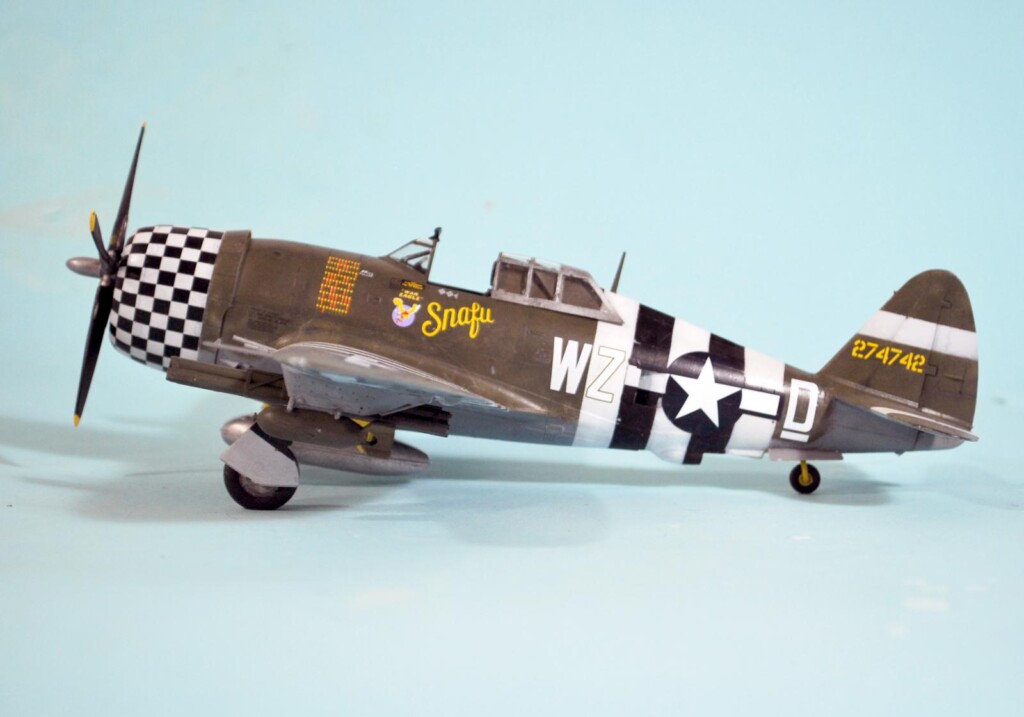
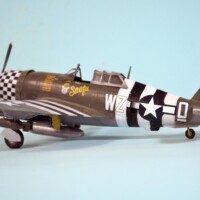
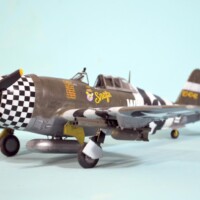
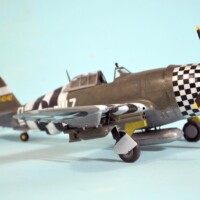
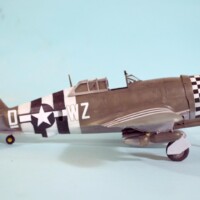
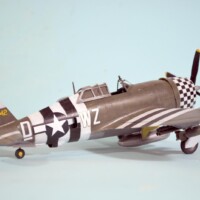
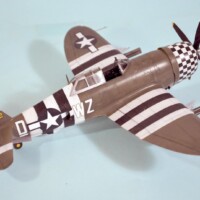
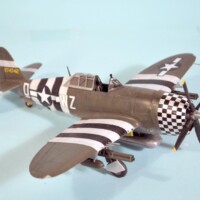
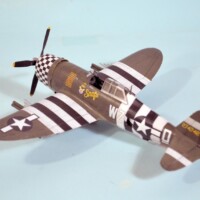
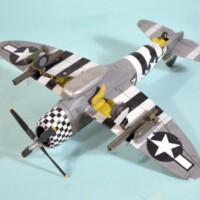


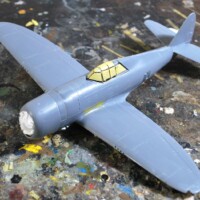
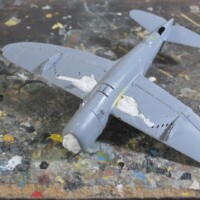
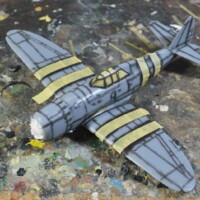
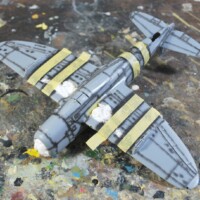
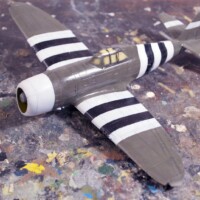
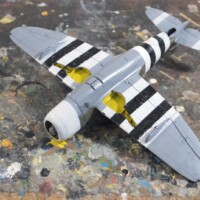
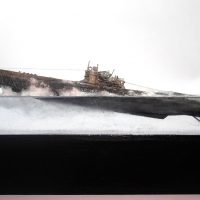
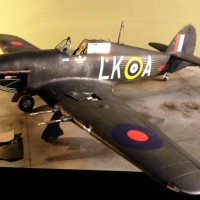
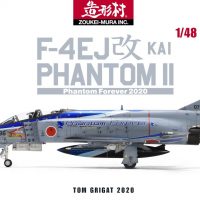
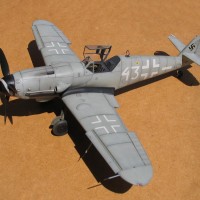
Amazing job, Tom!
Your articles are as always a joy to read and learn.
Great kit, decals and results! Well done, Tom!
Nice work, Tom. The satin finish looks spot on.
Nothing beats a fully loaded P-47 Razorback. Glad you decided to put another P-47 on the shelf and make a post. The checkerboard Cowling looks great, as well as the invasion/I.D. stripes!
Great looking model, Tom (@tcinla). I mainly use Tamiya paints, so thanks for providing the mixtures for the colors used. Tamiya paint is great, but doesn't have the range of colors that some of the other manufacturers have.
Nice work on this, I need to get one of these!
Nice looking build Tom, @tcinla, and I couldn't agree more about the kit. It really can be an effortless enjoyable build right out of the box. Relaxing and fun! Love the markings you chose for what is may favorite American fighter from WWII.
A brilliant T-Bolt! Looks fantastic.
Once again, a beautiful job, Tom! I love the satin finish and the very faint mottling of the OD paint. The last P-47 I built was the Monogram "Gabreski" kit and that was years ago. I think I need to build one of these. Thanks for the writeup.
Every modeler needs to do at least two Tamiya P-47s: one razorback, one bubbletop. And go check out ThunderCals for decals of groups nobody else has done.
Sounds like a plan. I've got to finish my MiG-21 PFL (Nguyen Van Coc) and then do the BV 141 my son gave me (he likes "eclectic" vehicles) for Christmas first.
Fine work Tom. @tcinla Finish looks especially good. I've not yet built a Tamiya T-bolt. The M version is in the storage closet and I may have to get to it soon!
Great looking Jug. Enjoy the write up as always.
A beautiful Razorback, Tom @tcinla
Not only a pleasure to looks at the result, also the supporting article is a pleasure to read.
Great chosen scheme and superbly applied.
Looks great Tom, very striking razorback! Aren't the Tamiya P-47 kits awesome?
Good lookin' Jug @tcinla! That's quite a leap from my old Testor's(ex-Hawk) P-47 "Okie" and such a nice model!
that's great work tom @tcinla very realistic I saw this in its shipping jig pre restoration fighter collection and you be surprised as to what it was painted as 56th FG AC